Welcome to the John Louis Petit website
“The greatest discovery in British Art for a generation….” Andrew Graham-Dixon
John Louis Petit was one of the most remarkable British artists of the 19th Century, and was a major influence in architecture of the period. His work was lost for over 120 years and is only now being rediscovered. He painted in a pre-Impressionistic style completely different from the mainstream or Pre-Raphaelites. He painted the Industrial Revolution and modern subjects unique for his time, as well as ecclesiastical buildings for his architectural criticism. As the leading opponent of those attempting to revive Gothic, Petit was the intellectual force behind all the non-Gothic architecture of the period, around half of all public buildings.
Information about JL Petit is on the Art, Architecture, Biography and Exhibition pages. Information about the Petit Society and its activities and services is in the Publications, Shop, Schools and About Us pages.
Contact us at enquiries@revpetit.com

Exhibition, Oakham, Rutland County, Aug-Oct 2025

In 2025, Rutland County Museum held the largest to date exhibition of Petit pictures available to the public. This covered Petit’s art of the East Midlands region, and included a group of pictures to provide a more representative range of his art. A card booklet (the third) portrays the highlights of the exhibition.
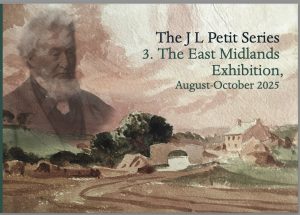
Following this and smaller exhibitions the Petit Society is now capable and resourced to mount major exhibitions and is in discussion with several regional venues. In addition to his home region of the Midlands, in Britain Petit was one of the most significant historical artists in Essex, along the South Coast, Devon, the West Country around Cheltenham and Gloucestershire, North Wales, Yorkshire and Northumbria.
Petit's Art and Wolverhampton - Demonstrating the 'Cradle of The Industrial Revolution'
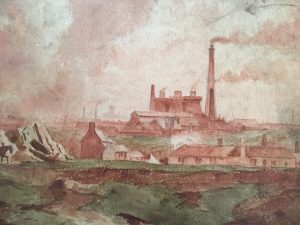 (Near Wolverhampton, 1853. Showing the Bilston works at Springvale.)
(Near Wolverhampton, 1853. Showing the Bilston works at Springvale.)
Petit’s art of industrial scenes, especially around Wolverhampton, are practically unique for the mid 19th Century. Furnaces such as this reflect all the power, and the problems that mass industrialization would bring.
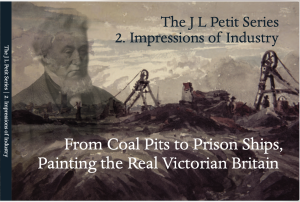 Petit would rile his opponents by claiming that such furnaces were actually picturesque, and displayed architectural power and propriety not seen since the Romans.
Petit would rile his opponents by claiming that such furnaces were actually picturesque, and displayed architectural power and propriety not seen since the Romans.
These pictures are shown in the second card booklet: Impressions of Industry – From Coal pits to Prison Ships, Painting the Real Victorian Britain. One furnace picture is on display in the Lichfield Exhibition (see below)
Other Petit Exhibitions (2025)
Lichfield Cathedral – JL Petit and The Lost Treasures of Lichfield
Staffordshire History Centre, Stafford – a selection of their pictures of North Staffordshire
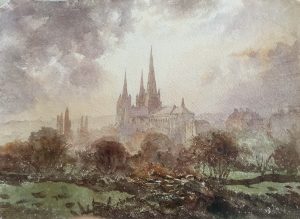 (Lichfield from the South East, 1857. One of the Series)
(Lichfield from the South East, 1857. One of the Series)
Petit painted views of Lichfield many times. These have been described as ‘the greatest series of pictures of a British Cathedral by any British artist’ (Robin Simon, Editor of the British Art Journal, 2024). Ten of the best of these are on permanent exhibition in the Cathedral Close Lichfield, together with other groups of pictures providing a good representation of his work. For opening see https://www.lichfield-cathedral.org/visit-the-cathedral/j-l-petit-exhibition.

From March 2025, the new Heritage Centre in Stafford exhibited some of their collection of Petit pictures. They included a few other items such as examples of his publications.
The Stafford History Centre has one of the largest groups of Petit’s art available in a public collection
Previous exhibitions
These include a significant pop up exhibition at the Reform Club, London, and displays abroad in Caen, and Vichy, France and Schloss Drachenberg on the Rhine in Germany (from 2022-2025)
Earlier Milestones
August 2024
The first permanent exhibition of Petit’s pictures was opened formally on July 14th 2024 at The Old Stables in the Cathedral Close. 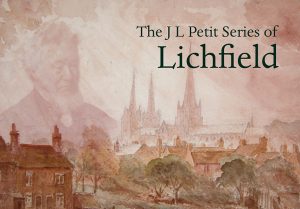
Launch of the first of several card booklets, this featuring the Lichfield Series, available as limited edition prints. The booklet includes endorsements by the Bishop of Lichfield and Robin Simon as well as detachable cards of the ten pictures in the Series.
September 2023
The new on-line exhibition is now completed, showing four themes in Petit’s art: 1) Painting well ahead of his time ‘The Pre-Impressionist’, 2) Artist of (some rarely painted aspects of) Victorian Life, are the two new ones. 3) Temples of Worship, and 4) Tours of Old Staffordshire consolidate what was in the previous on-line exhibition.
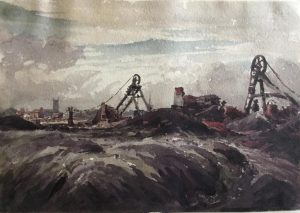
May 2023
Black Country Radio is scheduling another show about Petit and the beauty of both music and art from the Black Country. Philip Modiano and Billy Spokemon will be playing iconic music and discussing the great historical art of the Industrial Revolution.
See the pictures to be discussed by clicking HERE
November 2022
The Petit Society became a registered charity. The Bishop of Lichfield, Rt Revd Michael Ipgrave, and Dr Robin Simon, Editor, British Art Journal, became patrons of the Society.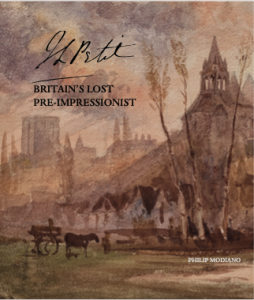
September 2022
J L Petit – Britain’s Lost Pre-Impressionist launched at a pop up exhibition in London’s Reform Club.
The book launch received widespread media coverage in newspapers (eg The Guardian), magazines (eg Country Life, Antique Collecting) and many other outlets in print and on-line.
There were presentations in the Black Country at the Wolverhampton Literature Festival, on Black Country Radio and in BlackcountryMan, and at the Lichfield Literature Festival.
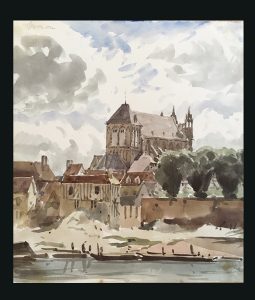
Andrew Graham-Dixon, author of A History of British Art, and broadcaster wrote:
“There has been nothing like this in the field of British art for a long time. This book marks the rediscovery of a more or less completely forgotten master – an artist whose work, particularly in the medium of watercolour, reaches the highest peaks of innovation and virtuosity, worthy of comparison with that even of Turner. High praise, but not too high.
What is also extraordinary about Petit’s work is the breadth of his subject matter and his remarkable lack of sentimentality. Few Victorian artists chose to bear witness to the effects of the Industrial Revolution on the fabric of life in this country, but Petit did anything but shy away from it: he painted factories and smogs with the same impassioned interest that he brought to the more traditional themes of the English watercolorist, such as village, church and cathedral.”
A 10 min video with Andrew Graham-Dixon and Robin Simon is at https://vimeo.com/755959918/a0c2de7ca2
March 2022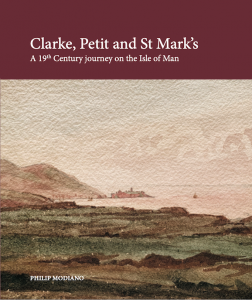
The first new publication this year is now available: Clarke, Petit and St Mark’s – A 19th Century Journey on the Isle of Man.
This booklet tells the story of John Thomas Clarke (1798-1888), Petit’s lifelong friend, who transformed the derelict district of St Mark’s, Isle of Man, with Petit’s help; and then late in life rescued Petit’s church at Caerdeon after Petit had tied, becoming its first vicar. Like Petit, Clarke has been forgotten even at St Mark’s through a combination of intrigue and accident. The booklet (48 pages) illustrates nearly all known Petit’s watercolours – 26, which have never been seen before.
October 2021
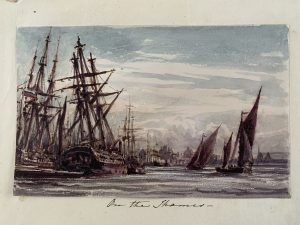
The remnants of an early album with 38 pictures still intact was discovered in a dealers store-room and acquired for the Society. They are mostly marine pictures from the Stour, Harwich and the attached of the Thames.
August 2021
We and The Historian were delighted with the entries for the essay prize for school students. The winning essay is here. It demonstrates our view that Petit, because of his modern views and steadfast opposition to prevailing orthodoxy, is very accessible to a younger generation.
June 2020
- Information boards in Lichfield are now up. One in St Michael’s churchyard near the family vault, and one, shared with the The Johnson Society, on Tamworth St in the City Centre where Petit formerly lived with his mother and sisters.
- The two albums of Petit’s pen and ink drawings for his first book have been discovered. 220 of the 285 drawings have been rescued by the Society and its individual members. Conservation is underway. We plan to offer limited edition prints of the drawings for sale through the website.width=”227″] St James, Gerrards Cross[/caption]
- An article has been published in The Historian, concerning St James, Gerrards Cross (architect Sir William Tite, 1857) and Petit’s influence on the design. The evidence is circumstantial but strong, since Petit had long advocated this style. Tite later acknowledged his debt. We hope it will lead to an upgrading of this church.


Contact
Please address all queries to enquiries@revpetit.com
Website last updated: October 2025